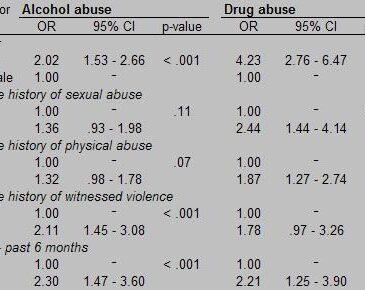Recent research indicates that a number of risk factors are linked to the development of Substance Use Disorders (SUDs) (Kilpatrick et al., 2000); these risks include traumatic events (Breslau, Davis, & Schultz, 2003; Simpson & Miller, 2002). Most of the research suggests that traumatic event(s) increase the risk for SUDs for young women, but not for young men (Becker & Grilo, 2006; Breslau et al., 2003; Lipschitz, Grilo, Fehon, McGlashan, & Southwick, 2000). However, this week’s STASH reviews a study of young adults (Danielson et al., 2009) that reports an association between traumatic events and SUDs among both young men and women, but the events differed across gender.
Methods:
- Participants were 43.5% (N=1753) of those who took part in the 7-8 year follow-up survey to the original National Survey of Adolescents (Kilpatrick et al., 2000).
- Investigators administered telephone interviews to participants between 18 and 26 years old (mean age = 22.12) who were residing in the United States and selected by using a random digit dialing procedure.
- 881 (50.2%) of the sample were male and 872 (49.8%) were female.
- The interview assessed alcohol and drug abuse, Post-traumatic Stress Disorder (PTSD), and the following traumatic events: sexual assault (SA), physical assault (PA) including severe physical punishment, and witnessed violence (WV).
- Interview questions that assessed PTSD in the past six months and past year substance abuse used DSM-IV criteria.
- Close-ended questions provided measures of SA, PA and WV. Introductory narratives, including a rationale and a behavioral description, illustrated each traumatic event.
Results:
- Table 1 shows the results for logistic regression analyses used to predict past year alcohol (N = 442, 25.2%) and drug abuse (N=197, 11.2%).
- Gender was a significant predictor for developing both alcohol and drug abuse (e.g., OR = 2.02 for men vs. female for alcohol abuse, and OR = 4.23 for men vs. female for drug abuse, both p-values < 0.001).
- Table 2 shows the gender related results for logistic regression analyses to determine whether traumatic events predicted alcohol and drug abuse for each gender separately.
- In contrast to the research currently available, traumatic events significantly increase the risk for alcohol and drug abuse in young men as well as in young women.
- The results show that young men and young women differ, however, by which traumatic events increase the risk for alcohol and drug abuse.
-
- For young women: SA increases alcohol and drug abuse, WV and PTSD increase alcohol abuse only.
-
- For young men: PA and PTSD increase both alcohol and drug abuse, WV increases alcohol abuse only, and SA was associated with a decrease for alcohol abuse.

Figure. Logistic Regression Analyses, Predictions of Past Year Alcohol and Drug Abuse (Adapted from Danielson et al., 2009). Click image to enlarge.
Figure. Logistic Regression Analyses, Predictions of Past Year Alcohol and Drug Use by Gender (Adapted from Danielson et al., 2009). Click image to enlarge.
Limitations:
- The study uses self report.
- The data was collected from telephone interviews; therefore, participation was limited to young adults who reside in a home with a telephone. The results, therefore, might not generalize to other population segments.
- Significant sample attrition occurred between the original 1995 NSA study and this study. Again, this raises questions about the extent to which we can generalize the results.
Discussion:
The results of this study indicate that specific traumatic events increase the likelihood of developing SUDs among males and females. Perhaps this risk disparity between genders emerges from which traumatic events a male or a female is more likely to experience. Some sources suggest that young women are more likely to report experiencing SA (Rentoul & Appleboom, 1997) and young men are more likely to experience PA and/or WV (Office of Justice Programs, 2006). Prevention programs could benefit by shifting their effort to focus on the different traumatic risk factors associated with the development of SUDs among young men and women (e.g., sexually abused women’s programs should focus more on alcohol and drug abuse risk reduction than other possible risks).
—Tasha Chandler
What do you think? Please use the comment link below to provide feedback on this article.
References:
Becker, D. F., & Grilo, C. M. (2006). Prediction of drug and alcohol abuse in hospitalized adolescents: Comparisons by gender and substance type. Behaviour Research and Therapy, 44(10), 1431-1440.
Breslau, N., Davis, G. C., & Schultz, L. R. (2003). Posttraumatic stress disorder and the incidence of nicotine, alcohol, and other drug disorders in persons who have experienced trauma. Archives of General Psychiatry, 60, 289-294.
Danielson, C. K., Amstadter, A. B., Dangelmaier, R. E., Resnick, H. S., Saunders, B. E., & Kilpatrick, D. G. (2009). Trauma-related risk factors for substance abuse among male versus female young adults. Addictive Behaviors, 34(4), 395-399.
Kilpatrick, D. G., Acierno, R., Saunders, B., Resnick, H. S., Best, C. L., & Schnurr, P. P. (2000). Risk factors for adolescent substance abuse and dependence: Data from a national sample. Journal of Consulting and Clinical Psychology, 68(1), 19-30.
Lipschitz, D. S., Grilo, C. M., Fehon, D., McGlashan, T. M., & Southwick, S. M. (2000). Gender differences in the associations between posttraumatic stress symptoms and problematic substance use in psychiatric inpatient adolescents. Journal of Nervous and Mental Disease, 188(6), 349-356.
Office of Justice Programs, B. o. J. S. (2006). Victim characteristics. Retrieved March 31, 2009, from http://www.ojp.usdoj.gov/bjs/cvict_v.htm#gender
Rentoul, L., & Appleboom, N. (1997). Understanding the psychological impact of rape and serious sexual assault of men: a literature review. Journal of Psychiatric and Mental Health Nursing, 4(4), 267-274.
Simpson, T. L., & Miller, W. R. (2002). Concomitance between childhood sexual and physical abuse and substance use problems. A review. Clinical Psychology Review, 22(1), 27-77.





